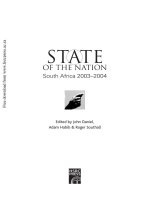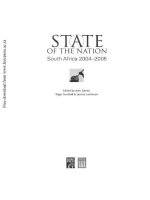NY RISING 2013 State of the State Governor Andrew M. Cuomo docx
Bạn đang xem bản rút gọn của tài liệu. Xem và tải ngay bản đầy đủ của tài liệu tại đây (2.51 MB, 326 trang )
NY RISING
January 9, 2013
October 29, 2012
NY RISING
2013 State of the State
Governor Andrew M. Cuomo
i
Table of Contents
1. Economic Development 1
Higher Education Centers as Job Generators 8
The Challenge: Tech Transfer—from Academia to
Commercialization 9
Create “Innovation Hot Spots” 14
Hot Spots will be Tax-Free Zones 15
Changing the Culture of Academic
Commercialization in New York: Create the
Innovation NY Network 16
Foster Investment through a NYS Innovation
Venture Capital Fund 17
Reducing Business Costs: Workers’ Compensation
and Unemployment Insurance Reform 18
Reforming the State’s Unemployment Insurance
System 18
Providing Workers’ Compensation Relief to
Businesses 20
Economy of Tomorrow: Make New York the Leader in
the Clean Tech Economy 26
Create a $1 Billion Green Bank to Leverage Public
Dollars with a Private Sector Match to Spur the
Clean Tech Economy 26
ii
Extend the NY-Sun Solar Jobs Program 31
Create the Charge NY Plan 33
Create a Cabinet-Level Energy Czar 36
Preparing the Workforce of Today and Tomorrow 38
Create the Next Generation Job Linkage Program 41
Partnering with the Regional Economic
Development Councils and Local Employers 42
Paying for Performance: Funding Based Upon
Student Success 44
Listening to Employers 47
Reimagining the State’s Workforce Development
System to Meet the Needs of 21
st
Century
Employers and Job-Seekers 48
Additional Focus on Upstate Economic Development
49
Market New York 49
Create the “Taste-NY” Program—Duty-Free Stores
to Promote NY-Grown and Produced Products 50
Market Regional Attractions 54
Special Events Marketing Campaign 55
The Adirondack Challenge 55
Increase Upstate Tourism through Destination
Resorts/Casino Gaming 56
iii
2. Education 61
More Learning Time: Extending the School Day
and/or Year 64
Full-Day Pre-kindergarten Program for the Highest
Needs Students 68
Better Teachers and Principals 70
A Success Story: The Teacher and Principal
Evaluation System 72
Better Teachers and Principals: Rewarding High
Performing Educators 73
Integrating Social Services and Schools by Expanding
Community Schools 74
Create a Performance Management System 78
Expanding Innovative Ways to Make Students College
and Career Ready 78
Create Innovation Zones 80
Continue to Find Efficiencies through Shared Services,
Regionalization, and Consolidation 81
Another Round of NYSUNY 2020, and a New NYCUNY
2020 82
3. Progressive Agenda 85
We Must Raise the Minimum Wage 92
The Challenge: Stop and Frisk 95
The Challenge: Marijuana Possession 98
Strengthening Eyewitness Identification 104
Recording Criminal Interrogations 106
iv
Create the $1 Billion House NY Program 108
The REDC Opportunity Agenda 112
Achieving Equality for Women: The 10-Point
Women’s Equality Act 114
Shatter the Glass Ceiling: Achieve Pay Equity 115
Stop Sexual Harassment in All Workplaces 119
Allow for the Recovery of Attorneys’ Fees in
Employment and Credit and Lending Cases 120
Strengthen Human Trafficking Laws 121
End Family Status Discrimination 122
Stop Source of Income Discrimination 123
Stop Housing Discrimination for Victims of
Domestic Violence 124
Stop Pregnancy Discrimination Once and For All
125
Protect Victims of Domestic Violence by
Strengthening Order of Protection Laws 126
Protect a Woman’s Freedom of Choice: Enact the
Reproductive Health Act 127
Fighting Hunger in New York 129
Increasing MWBE Opportunities 137
Creating “CORe” Neighborhoods 142
A Focus on Public Health 147
New York to Set the “Gold Standard” for Patient
Care 148
v
4. Public Safety 156
New York State: Safe and Fair 156
We Must Pass a Tough Assault Weapons Ban: The
Rest of the Nation will Follow New York 163
One State, One Standard 166
Preventing Private Sales to Prohibited Persons 167
Reporting by Mental Health Professionals 167
More Efficient Issuance of Licenses 168
Enhanced Penalties 168
Gangs and Guns 169
Combating Gun Violence in the State’s Most Violent
Neighborhoods 170
Staying Ahead of the Game on Dangerous Designer
Synthetic Drugs 172
New York State Cyber Security Initiative 175
5. Government Reform 182
Create Disclose NY to Increase Disclosures of
Contributions 188
Campaign Finance Reform is Imperative for
Rebuilding Trust in Government 189
Public Financing of State Elections 191
Lower Contribution Limits 194
New Enforcement Unit 195
Early Voting Ensures Easy and Effective Voting 195
Make Our Ballots More Readable 198
vi
Create the Financial Restructuring Assistance
Program 199
Create OPEN NY: Using Technology to Promote
Transparency, Improve Government Performance,
and Enhance Citizen Engagement 201
6. Responding to the Crisis 206
We Must Respond to the Crisis 213
Lower the Regional Greenhouse Gas Emissions Cap
214
Increase Alternative Local Renewable Power Sources
217
Ensure a Skilled Energy Workforce 221
Improve the Resilience of Our Buildings 223
Provide Assistance to Property Owners to Mitigate or
Sell Properties in Vulnerable Areas 224
Recreate NY-Smart Home Program 225
Recreate NY-Home Buyout Program 225
Ensure that Healthcare Facilities are Resilient 226
Take Immediate Steps to Strengthen Coastal
Protections 227
Toward a More Resilient New York Harbor 229
Take Immediate Steps to Protect Transportation
Systems Against Future Storm Events 232
Harden our Fuel Delivery System 234
Harden our Utilities 237
Strengthen Wastewater Infrastructure 239
vii
We Need to Redesign Our Power System 241
Put Enforcement Teeth into the PSC to Improve
Oversight and Regulation of State’s Utilities 241
Abolish the Long Island Power Authority 244
Establish a World-Class Emergency Response
Network 246
Specialized Training for the National Guard for
Emergency Response 248
Establish a Statewide Volunteer Network 249
Establish a “Civilian Emergency Response Corps” . 251
Establish a Private Sector Emergency Response Task
Force 253
Launch a Citizen Education Campaign: Prepared
citizens as “in-house first responders” 254
Ensure that Vulnerable Populations Can Receive Help
in an Emergency 255
Communicating with New Yorkers in an Emergency
256
viii
GOVERNOR ANDREW M. CUOMO
NY RISING
Two years ago, I said we were at a crossroads;
that New York needed to chart a new course and begin a
journey to rebuild our state. It was imperative that we
restore the public trust and renew the dream and
reverse decades of decline.
We started a New York comeback. The core
elements of a New NY are: attract good jobs and
economic growth; create a world-class education
system that prepares the next generation for the future;
establish fiscal integrity and discipline; and restore New
York as the progressive capital of the nation.
As Al Smith said, “Let’s look at the record.”
Gone is the obstructionist state bureaucratic
culture; replaced with a new “entrepreneurial
government.”
Gone is the tax capital mentality; replaced with a
property tax cap, a new pension system (Tier VI) and
the lowest middle class tax rates in 58 years.
ix
Gone is the anti-business mentality; replaced
with regional collaboratives and a new public-private
partnership.
Gone is the political gridlock; replaced with a
government that works for the people.
Our State Capitol is restored physically and
symbolically, and our government is performing better
than it has in decades.
We set out to bridge the divide between
yesterday and tomorrow, what was and what can be,
dysfunction and performance, cynicism and trust,
gridlock and cooperation to make government work.
And we are.
Look at our progress on replacing the Tappan
Zee Bridge. We did in one year what was only talked
about for the past ten years. The new Tappan Zee
Bridge is BIG, BOLD and BEAUTIFUL.
My friends, I would like to say that our job is
done. But, we have much more to do.
The national economy is better than it was, but it
is not driving recovery at a fast enough pace.
Our mantle as the progressive capital is a
continuing responsibility.
Upstate New York needs more investment.
x
All children are not being educated to the fullest.
Women are not treated equally and fairly.
Mother Nature has not been kind to us.
But our accomplishments over the past two
years show us that one thing is clear: We can defy the
odds and deny the naysayers. We can accomplish
anything together.
So let us begin.
xi
1
1. Economic Development
For too long, New York State’s economy lagged
behind much of the nation. Our state had experienced
substantial job losses and the exodus of businesses.
State government struggled under staggering budget
deficits and failed economic development policies.
Changing the future of our state required reviving our
economy. Governor Cuomo’s top priority from the day
he took office has been strengthening New York’s
economy and creating jobs.
To achieve that goal, the Governor thoroughly
redesigned the State’s economic development strategies
through the creation of Regional Economic
Development Councils, which replace top-down
development strategy with an approach that enables
each region of the state to shape its own economic
2
future. The ten Regional Councils brought together
stakeholders from labor, business, and academia to
develop long-term strategic plans based on each
region’s specific priorities and unique resources. The
Governor also realigned State resources and regulations
to support the Regional Councils and eliminate barriers
to economic development. These Councils were part of a
process that awarded $785 million in grants for job
creation and community development in 2011, and
$738 million in new State funding and tax incentives in
2012.
The New York Works program, a centerpiece of
the Governor’s Open for Business agenda, exemplifies
an entrepreneurial model of government. New York
Works fosters an innovative and synergistic strategy
between government and the private sector, allowing
the State to leverage scarce resources by generating
significant private-sector investment. The New York
Works Task Force, composed of leading finance, labor,
planning, and transportation professionals, is charged
with reinventing state economic development by
coordinating capital plans across 45 agencies and
authorities, overseeing investment in projects, and
accelerating hundreds of vital projects across the state,
3
including improving 55 parks and historic sites,
inspecting and repairing 114 dams and flood protection
and coastal erosion projects, repairing 2,100 miles of
roads, and improving more than 100 bridges.
Governor Cuomo, working with the State
Legislature, enacted a new law allowing the use of
design-build techniques on New York Works projects.
1
This streamlines the contracting process by holding a
single contractor accountable for both the design of the
project and its actual construction, with the potential to
save 9 to 12 months on the project timeline for bridge
repair and construction.
The centerpiece of the New York Works
infrastructure program is the replacement of the
Governor Malcolm Wilson Tappan Zee Bridge in the
Hudson Valley, which has been needed for years. Plans
for a new bridge were announced more than ten years
ago. The State held 430 public meetings and explored
150 different bridge concepts. But New Yorkers still had
not seen any results. Governor Cuomo put forward a
plan for a new bridge that considered the future transit
needs of the region; the plan increases lanes for drivers,
creates emergency lanes and shoulders to handle
accidents, includes a pedestrian and bike lane for the
4
benefit of local communities, and will boost the
economy of the region by creating and sustaining
45,000 jobs. And about one year later, on December 17,
2012, the Thruway Authority awarded a contract for the
new bridge at a cost $800 million less than the next
lowest bidder and approximately $2 billion less than the
original estimate. Work on construction will begin in
2013.
New York’s typically high energy costs have long
been a barrier to growth of the state economy. The
Energy Highway initiative, introduced in the 2012 State
of the State address, is a centerpiece of the Governor’s
Power NY agenda, which was put in place to ensure that
New York’s energy grid is the most advanced in the
nation and to promote increased business investment in
the state. In October 2012, the Energy Highway
Blueprint was launched, identifying specific actions to
modernize and expand the state’s electric
infrastructure. The comprehensive plan, supported by
up to $5.7 billion in public and private investments, will
add up to 3,200 megawatts of additional electric
generation and transmission capacity and clean power
generation.
5
Knowing that New York’s future economy lies in
innovation and high-technology as well as in the
traditional transportation of goods and people,
Governor Cuomo also launched NYSUNY 2020—a
sustained, competition-based model to support job
growth through our universities. The NYSUNY 2020
Challenge Grant Program, a joint program between the
Governor and the State University of New York (SUNY),
supports individualized long-term economic
development plans on SUNY campuses and in the
surrounding communities. The program enhances
SUNY’s academic mission, maintains academic
affordability, and places college campuses across New
York at the center of the state’s regionally based
economic revitalization strategy. The 2012-13 budget
included capital funding in the amount of $60 million
for a second round of up to 12 challenge grants funded
by the State and SUNY.
The model follows a strategy Governor Cuomo
announced in a landmark deal that signaled an
important change in the direction of the state. In
September 2011, the State entered into an agreement
for a joint $4.4 billion investment with five international
technology companies, including IBM and Intel, that
6
would make New York the international center of next-
generation computer chip technology. The investment
will establish research and development facilities
throughout the state, creating and retaining nearly
7,000 jobs.
New York’s diverse economy is driven by other
industries as well. Tourism, for example, is a significant
contributor to the economy of New York, directly
supporting nearly 500,000 jobs and generating tens of
billions of dollars in revenue for New York businesses.
To support the state’s tourism industry in 2012,
Governor Cuomo launched summer and fall advertising
campaigns that used the iconic “I Love NY” logo to
promote New York’s unmatched vacation destinations,
and also launched the “Path Through History” initiative
to better highlight New York’s rich heritage.
Another economic mainstay is New York’s film
and television industry, one of the most robust in the
nation, and supporting hundreds of thousands of jobs
and billions of dollars in economic impact. In July,
Governor Cuomo signed legislation to help attract post-
production work to the state, particularly upstate
communities. A number of major film and television
7
productions have cited the State’s program as a leading
factor in their decision to film and produce in New York.
No element of New York’s economy is more
important than small businesses, which compose 98
percent of all businesses and employ more than half of
the private sector workforce in New York. To support
the development of small businesses, Governor Cuomo
created a statewide small business outreach initiative to
help this vital sector grow.
Helping emerging businesses is also at the heart
of New York’s support for the burgeoning Greek yogurt
industry. Greek yogurt has become wildly popular
across America, and New York State has quickly become
the yogurt capital: since 2000, the number of yogurt
processing plants in New York has more than doubled,
and over the past six years the amount of milk used to
make yogurt in New York increased from 158 million
pounds to about 1.2 billion pounds. Governor Cuomo
hosted New York’s first Yogurt Summit to hear first-
hand from industry leaders, farmers, and other
stakeholders about ways to remove barriers and
support further growth of the industry, and announced
new actions to help dairy farmers increase milk
production, better manage the large amount of waste
8
produced by cows, and save money on energy costs by
turning waste into a renewable source of energy.
The approach worked so well that the Governor
applied this same technique to supporting New York’s
450 wineries, breweries, distilleries, and cideries, which
account for more than $22 billion in economic impact
each year and support tens of thousands of jobs
statewide. The Governor signed a legislative package
providing critical incentives and tax relief for New York
State’s craft and farm brewers, which support more
than $200 million of annual economic activity.
Following the State’s first Wine, Beer and Spirits
Summit, which again brought experts and government
officials together, the Governor announced plans for a
new marketing campaign to promote production, sales
and tourism, as well as a series of regulatory reforms
that will significantly reduce business costs for
beverage producers.
Higher Education Centers as Job Generators
This year’s economic development program will
build upon the work of the Regional Economic
Development Councils as well as the partnership with
9
Many of the country’s most significant high-tech
economic clusters owe their success to technology
transfer. Since the research at Stanford University
and the University of California at Berkeley
spawned Silicon Valley in the 1950s, a number of
highly successful university-driven economies
have emerged in the U.S.
higher education, because New York’s one-two punch is
jobs and education.
The Challenge: Tech Transfer—from Academia to
Commercialization
The knowledge-based economy and global
competition make it more important than ever that New
York State becomes the leader in innovation and new
business creation. New York possesses one of the best-
educated workforces, due to the state’s many colleges,
universities and other research institutions that lead
the nation.
In fact, New York has all of the ingredients to
make this state the leader in economic opportunity if
we harness our assets more effectively by facilitating
the process of commercializing academic ideas or
10
inventions and building companies around them. This is
a process that can be broadly described as “technology
transfer” or “tech transfer.”
Many of the country’s most significant high-tech
economic clusters owe their success to technology
transfer. Since research at Stanford University and the
University of California at Berkeley spawned Silicon
Valley in the 1950s,
2
a number of highly successful
university-driven economies have emerged in the U.S.
These include Research Triangle Park in North Carolina,
which is driven by the three research universities there;
Austin, Texas, whose success is tied to the University of
Texas at Austin; and Cambridge, Massachusetts, as a
result of work done at Harvard University and the
Massachusetts Institute of Technology. The economic
strength of these regions is the direct result of the
creation of a comprehensive technology transfer
infrastructure, which includes state-of-the-art research
and development, the licensing of patented inventions,
pilot prototyping, workforce training, and partnership
with industry.
11
New York only ranks
22
nd
in industry
sponsored research
compared to North
Carolina, which is 1
st
.
Although there have been some noteworthy
success stories, New York has not done as good a job as
these other areas in
leveraging its research
strengths to drive
economic growth.
3
A
2010 Report by the
Task Force on
Diversifying the New
York State Economy
through Industry-Higher Education Partnerships
4
found
that while New York was near the top nationally in total
research expenditures, it lagged significantly behind
other states in successfully commercializing those
research ideas.









